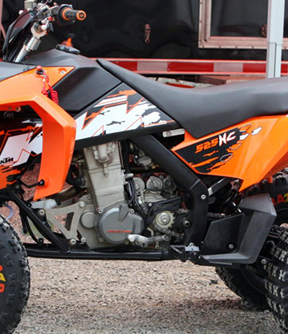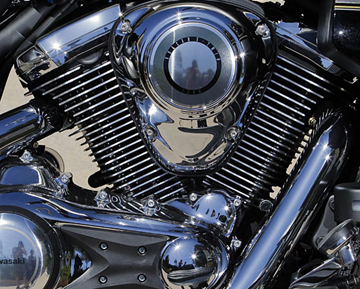ATV Four Stroke Engine Guide
A Look at the Engine Configurations Adorning the Modern ATV


Now that the world that is the ATV industry has officially made the transition to four stroke engines exclusively, the editors of ATV Connection feel we’re long overdue in assembling a handy guide for identifying the various configurations gracing quads these days. From all out race equipment to trail rigs, beginner quads and everything in between, the modern four stoke engine typically comes in one of the following four designs:
High-Performance
The configuration of today’s race engines typically comes set up in short stroke, liquid cooled, dual overhead cam (DOHC), four valves per cylinder configuration.
Short stroke (the length of the cylinder) coupled to nearly-flat (skirtless) pistons results in very low reciprocating mass during each cycle. Small valves are implemented to handle the high RPM and a valve train without rockers further accounts for decreased friction.
All of this results in engine revs that are able to build quickly, an essential for making up ground in tight confides. Relatively large cylinder bores creates room in the head for multiple valves; which allows for a better breathing power plant. Since the cams open the valves directly, there is absolutely no rocker mass to weigh down the valve springs even at high rpm applications.
Bottom line- fastest building and freest revving configuration to get the power to the ground in a hurry. The downside is that this type of engine, because of its higher RPM range, typically requires the most maintenance/ most frequent rebuilding.
Middle Ground
To compensate between the upper echelons of performance and some of bullet-proof reliability of yesteryear’s four-strokes, a single-overhead cam (SOHC)/ multi-valve engine may be just the ticket and machines like KTM’s XC series make use of this configuration.
The primary difference between this and the dual cam configuration above is that a single cam operates the four valves using rocker arms (rather than cam to valve directly). Roller bearing equipped rockers actually give up little to nothing in the way of friction to the DOHC designs, making this configuration a tried but true means of performance and reliability.
Working Class
Not all ATVs need arm-stretching acceleration and will gladly trade away some of the complex technology in favor of reliability and steady performance. Enter the single overhead cam (SOHC) twin-valve configuration. In this design a single cam operates one intake and a single exhaust valve through rocker arms.
Simplicity and bulletproof reliability do come at a cost however, as these engines suffer from increased friction and hence fairly low RPM capacity. Beginner quads and machines designed for lower-rpm work and utility duty are the prime beneficiaries to this configuration.
Rod Pushing
On the opposite side of the spectrum is one of the older four-stroke designs called a pushrod or Overhead Valve (OHV) engine. In this design the camshaft is literally located within the cylinder block (rather than above it as is the case with the overhead designs).
Because the camshaft is located inside the engine block, OHV engines are typically more compact than an overhead cam engine of similar displacement, which is perfect for large displacement engines that must be squeezed into restrictive frames.
This configuration makes use of long pushrods, which open and close the valves via rockers. As is always the case with increased mass in motion, friction is a big factor with the pushrod engine. Since these engines do their best work in the low-middle RPM range (very little high revving), manufacturers generally apply them into machines designed to provide a smooth and easy riding experience. They are also quite common in engines with multiple cylinders.
